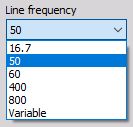Configuration
After adding new Power module, a screen like this will appear:

This screen is divided to the following two main sections:
Depending on the type of system, Dewesoft calculates and outputs different channels. For Single Phase, 2-phase and 3-phase with default settings and additional channels if extra calculations are selected.
Power system configuration
We can define type of power system from Power system configuration drop down list.

Dewesoft enable following types of power modules:
- DC measurement
- Single phase AC measurement
- 2-phase AC measurement
- Five types of 3-phase AC systems:
- Star configurations
- 3-phase star
- 3-phase Aron (only two current measurements)
- Delta configurations
- 3-phase delta
- 3-phase V (only two currents)
- 3-phase with two wattmeters (only two voltage and two currents)
- Star configurations
All AC types can have the current measurement either enabled or disabled. Multiphase systems also allow calculating the line-to-line voltages.
For closed description of these types see → Wiring scheme.
For information about Current channels and Calculate line voltages see → Power module calculations.
Common Power module settings
In this section you can define several settings:
- Power system configuration
Current channels and Calculate line voltages For information about Power system configuration see → Configuration, Wiring scheme, Calculations. For information about Current channels and Calculate line voltages see → Power module calculations.
Line frequency - Line frequency depends on the grid frequency. We can have 16 ⅔ Hz (in trains), 25 Hz, 50 Hz (Europe), 60 Hz (USA); 400 and 800 Hz (vehicle power systems) or Variable (for frequency converters).

Number of cycles - Choose from the drop-down list or freely enter any value. Standard values are 10 for 50 Hz grids and 12 for 60 Hz grids. This basically defines the measurement interval.

Output units - Choose power unit for your system from the drop-down list.

Nominal voltage - Choose nominal voltage of your system from the drop-down list or enter any other value.

Frequency source - Source for frequency measurement can be: Voltage, Current or External input channel and can be selected from the drop-down list.

When we select External as source, input channel for this source can be selected from the drop-down list of available channels.

Voltage is the most common source for frequency measurement. Current is used most widely with frequency converters. External frequency is mostly used on distributed systems when we want to have only one source for frequency.